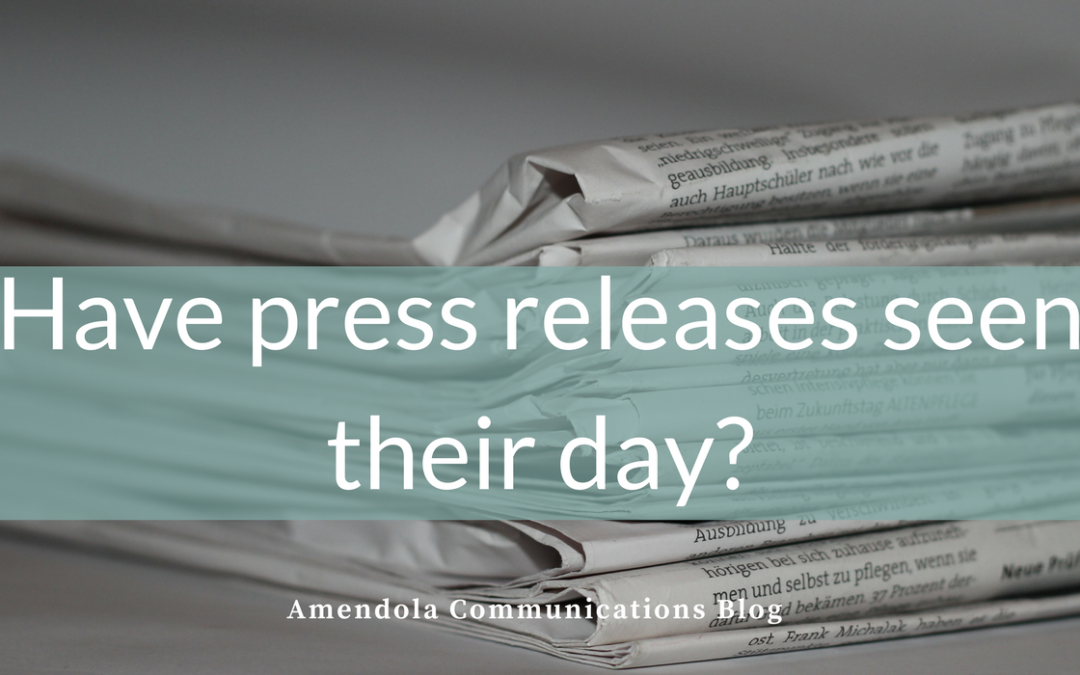
by Brandon Glenn | Jun 10, 2020 | Blog
Another year, another Cision “State of the Media” report.
The 2020 edition, which represents the 11th annual report in the series, surveyed more than 3,200 journalists from across the globe to provide a picture of today’s media landscape. While much of the yearly report generally reads like PR 101 for experienced public relations professionals, it often contains some nuggets of interest that are worth further reflection.
In that spirit, following are a few notes and observations after digesting the 29-page report:
COVID-19 did NOT change everything: In the marketing and public relations worlds, things can seem to change fast, so it can get easy to become caught up in the moment and lose a little long-term perspective. Don’t allow COVID-19 to let that happen to you. Yes, our professional lives during the pandemic are undoubtedly different in many ways, but lots of things in the media world remain largely as they were pre-pandemic. Email is still the preferred method of pitching. Journalists still want to hear from local and national experts who can offer perspectives that illuminate their audiences. To cut through the noise, pitches still need to be timely, relevant and targeted. These things are unlikely to change any time soon.
The media business continues to be brutal: The COVID-19 pandemic has exacerbated what was already a years-long trend of the media business shedding jobs. Journalism advocacy organization Poynter maintains a depressing and frequently updated list of recent industry layoffs that illustrates the severity of the problem. For reporters and editors, a lack of staffing and resources was cited in the Cision report as the biggest challenge they face. For public relations outreach, this presents a challenge as the number of media outlets continues to dwindle, but also represents an opportunity as individual journalists are under pressure to produce higher volumes of content and could use help finding stories.
Press releases are still relevant: In spite of its obituary having been written a number of times over the years, the humble press release remains very much alive. In fact, journalists who took the Cision survey cited the press release (36%) as the most useful of all brand sources, beating out spokespeople (19%), email pitches (13%) and company websites (12%). For marketing and communications professionals, this qualifies as great news: There is still a place in the world for the well-crafted, well-timed and appropriately targeted press release.
The major takeaway? The more things change, the more they stay the same. Given the barrage of news and information we’re confronted with on a daily basis, separating the signal from the noise is rarely easy for anyone let alone journalists dealing with budget cuts and shrinking staffs. Standing apart from the pack requires the same focus and commitment to timely and relevant messaging that it always has.

by Lisa Chernikoff | Apr 11, 2018 | Blog
We’ve all heard of analysis paralysis the state of over-analyzing or over-thinking a situation so much that a decision is never made and the outcome is impacted. Recently I’ve been witnessing a curious yet similar phenomenon at healthcare IT companies across the country and the analysis paralysis is all about “strategy.” As in overall corporate strategy and direction.
In short, these companies are all about strategic planning, but in the end they seem to come out of it having virtually no strategic plans. They’re all about all-day strategy meetings which result in no strategy but rather more questions that prompt more all-day meetings and shockingly, yet still no strategy.
From the outside looking in, this cycle is an endless hamster wheel that leaves team members feeling tired rather than energized, frustrated rather than empowered, and most troublingly, so terrified that their actions won’t follow the still-to-be-approved (or never-to-be-approved) strategy that they simply don’t act. This inaction can be minor or major as it builds up over time but it’s always detrimental.
Back to basics to get results
Their “strategic focus,” while well-intentioned, sets companies on the wrong path in the short and long-term, especially in regards to PR which should have a constant, ongoing cadence to create momentum and maximize results.
While company strategies can be complicated and have a profound impact on PR efforts, many aspects of PR strategy are quite uncomplicated. In fact, there are core tenets which are quite basic and fundamental to any sound PR plan. There are the pillars that cannot be disputed so they need not be delayed regardless of executive indecision.
Whether your strategy is set or you’re one of many stuck on the endless hamster wheel, these four actions are key to success. They are mission-critical, and safely fit into any PR strategy for 2018 and beyond:
1. Write and distribute press releases
It sounds like a no-brainer but for many companies it’s not because they live in fear of being “off brand” or “misaligned.” They live in fear of putting out too many press releases yet not enough press releases. Those fears are unwarranted though since your company is doing good work. Why shouldn’t it be shared? Did you develop a new product? Let’s write a release. Did you sign a new customer? Let’s write a release. Is your CEO speaking at an industry event? Let’s write a release.
Writing a press release is one of the simplest ways to communicate what’s happening and why it matters. Distributing those press releases positions your company as a key player and thought leader in the ongoing industry dialogue. It’s not complicated. It doesn’t need to be debated and as long as you’re not regularly putting out more than 2-4 press releases per month, you’re not overdoing it. So, just do it.
2. Highlight your customer’s success stories
Once again, it sounds like a no-brainer. You have customers. They like your products. They like your team. They have achieved impressive results that they’re willing to share. Let them be your advocates. Capture their stories in writing. Put them in front of reporters who are eager to hear from both executives and end-users at provider organizations. It’s as simple as that. Just like with press releases, these customer success stories illustrate that your company is doing good work and that’s what makes more customers want to work with you, which of course is one of the biggest end goals of any strategy. It’s not complicated. It doesn’t need to be debated. As long as your customers are singing your praises, hand over the microphone and let them sing.
3. Emphasize your expertise
In addition to highlighting your clients, highlight your company’s thought leaders. After all, they are also doing good work (you may see a pattern here). They have knowledge to share. They have ideas to contribute. They are the faces of your company and you need some faces even if you don’t have a final strategy. This action can mean authoring bylined articles or blogs on their behalf or pitching them as experts for media interviews. By positioning your executives and SMEs as thought leaders and joining the industry conversation, you’re helping to make your company a go-to source for future media opportunities. It’s not complicated. It doesn’t need to be debated and it would really be a shame for their knowledge to go to waste.
4. Educate your sales team about PR efforts
Regardless of strategy indecision, your sales team needs to close deals. There is nothing off-strategy about building your business. Media placements from your PR efforts are one of the most powerful but underutilized tools in your sales team toolkits. Obviously, sales prospects are not interested in the same information as the media. In fact, they may be turned off by being sent a press release about a new client that just signed on. However, they may be very interested in press coverage from well-regarded industry publications that profile your company news, thought leadership, and customer success stories. That is not only informative but also adds credibility and implies that you want to keep them in the know.
Similarly, if one of your client case studies is featured in a third-party publication, that’s a prime opportunity to reach out, share the article and offer a reference call with the client quoted. It’s not complicated. It doesn’t need to be debated and if you’re earning media placements it is certainly a shame not to use them to their fullest potential.
It’s time to get off the hamster wheel and get on with the real work that makes a difference.

by Marcia Rhodes | Feb 7, 2018 | Blog
Entrepreneur recently ran a scathing article blasting press releases titled, Is Sending Out a Press Release Really Worth the Money? The article questions the value businesses receive from issuing press releases, calling releases “borderline useless,” serving mainly as a way for PR agencies to fleece clients.
I beg to differ.
As someone who has been in PR her entire life (we’re talking 3+ decades), I have seen numerous benefits from press releases when done right. I have even seen how they optimize SEO, as long as you follow a few best practices, which I’m happy to share in this blog.
Among the accounts I currently handle, one issues a single press release per year, while another issues one per month. Guess which one gets a lot more press coverage?
Perhaps I seem a bit defensive given I work for a PR agency. Fortunately, several of my colleagues are former reporters and editors themselves.
Here is how they view press releases:
Michelle Noteboom, senior account & content & director (former health IT blogger and columnist)
How else can you communicate to the industry what’s going on? For example, announcing new clients (so that prospects and competitors know you are growing), new product updates (especially if they are innovative) or new funding.
Press releases can also help attract traffic to your web site so you can communicate even more about your company and offerings.
However, if you have nothing but fluff to report, I agree that you should not do a press release!
Brandon Glenn, content & account director (former editor, Medical Economics)
As a former reporter, I can say with certainty that journalists still pay attention to press releases and find them a useful tool to stay informed about the companies and industries they cover. Press releases are by no means the be-all-and-end-all of PR tactics; they alone aren’t going to create record-breaking sales numbers. They’re merely one tool in the toolbox and a generally useful one as part of an overall strategy to generate awareness.
Ken Krause, senior account & content director (contributing editor for a sports magazine)
Well-written press releases are a great way to organize information. They help companies think through how to present their stories and messaging, and deliver them in a manner that’s easy for reporters, clients, and prospects to absorb. They provide more depth when pitching reporters the pitch can highlight what’s most newsworthy while the press release can deliver more details as to why it’s newsworthy. If you use a wire service, they also guarantee that the news will be out on the web so it can be discovered in a search.
There is one other value, and that is in placing it on your web site in the news section. Job candidates and sales prospects use web sites for company research, and a lack of news makes it look like not much is happening. Having a full and active newsroom creates a positive impression of your organization.
Chad Van Alstin, content & media relations manager (former editor of a health IT magazine and a sports publication)
To be frank, as an editor, I thought only a small percentage of press releases were worth immediately writing a story on.
But, that’s not their true value. Press releases are useful for the dissemination of information, and are a great way to keep journalists apprised of relevant news. More than that, they’re a good reminder for journalists that your company exists and its leaders are available for comment when the need arises. Lastly, press releases serve the function of boosting SEO through shared publication.
Not all of these benefits can be quantified and measured, and the benefits certainly aren’t true for every release I’ve seen some bad ones. But, in general, a press release is a great tool that is as valuable in the new media, Internet era as it was during the days of print.
Tips for writing SEO-powered press releases
In order to maximize the ROI from issuing a press release, be sure to do the following:
- Spend the time creating a powerful headline and subhead. Headlines should be under 100 characters to make it easily shareable on social media. Include the most important information in the first 50-65 characters, because that’s typically where Google cuts off the headline preview.
- Be sure to use keywords in the headline and lead paragraph. You never want to stuff keywords into a release (Google punishes that), but when you write naturally and have a good focus, keyword optimization will fall into place.
- Use variation in the text to break up blocks of text. One way to improve SEO is to make changes to the text that draws the user’s eye, and helps the information be absorbed more easily. Use bulleted or numbered lists, subheads, bolding and italics.
- Include no more than three links per release. It’s important not to have too many or Google starts suspecting your content of being link spam. Did you know that duplicate links can hurt your SEO? This is why it’s best not to link to the company name in the opening sentence; save it for the boilerplate.
- Consider multimedia news releases. Including any form of multimedia in a release boosts SEO (think about how much more likely you are to click on an article that has an image vs. text only). Click here to see a recent example.
If you read the Entrepreneur article and agree with it, it could be that you are issuing press releases on a wire and hoping something good will come of it. That’s actually why you need a PR agency, to make sure the release is SEO-optimized, to do the follow-up, to see to it that the news gets in front of the right journalists. With more and more companies fighting for the attention of fewer and fewer journalists, the value of the PR agency in this process increases considerably.

by Ken Krause | Jan 10, 2018 | Blog
One of the core tenets of journalism (and public relations, which at most colleges is part of the School of Journalism) is the use of AP style when writing. AP, of course, stands for the Associated Press, whose manual and rules are drilled into journalism students from the day they begin writing for their school newspaper (or whatever aspiring writers write for in school these days).
For a PR professional, use of AP style demonstrates that you are a journalism insider. That’s very important when you’re pitching a byline article, or a press release, or some other piece of content that needs to be reviewed and approved by an editor. It gives you a certain level of credibility, or at least signals to an editor that he or she won’t have to spend untold hours bringing your writing up to par.
Failure to use it, on the other hand, is generally seen as an admission that you are an ignorant hack whose writing skills would be best applied to warning labels on pet supplies. No one wants that.
This, of course, is the reason Amendola Communications is very careful about conforming to AP style. It benefits not only our agency but our clients.
Still, for those who aren’t familiar with AP style, some of its peccadillos can be a bit off-putting. They’re not used to seeing things written that way, and their preference for the approach they’re used to can become a bone of contention that slows down the writing and approval process.
Here’s the reality of the situation. When you are writing for your own blog, or marketing materials, or internal memos, etc. go ahead and let your preferences dictate the style. But when you’re writing something you’d like to have published by an independent media outlet, it’s important to follow AP style.
So what does that mean from a practical standpoint? Glad you asked! Here are five examples of the differences between regular people style and AP style. Those of you who are familiar with it please feel free to add additional common uses in the comments section.
Capitalizing corporate titles or not
This is the one that probably causes more consternation between Amendola Communications account managers and clients, so let’s start there.
Most people are taught in business writing courses to capitalize someone’s title, such as President, or Chief Medical Officer, or Vice President of Some Made Up Area that Sounds Good on LinkedIn. It’s viewed as disrespectful not to capitalize the title.
That is not the case in AP style. Titles are never capitalized, unless they are used as part of the person’s identity. Which means you can refer to President Trump with capital letters, but you would write Donald J. Trump is president of the United States.
This, by the way, is one of the easiest tests for editors and journalists to see who knows what they’re doing. Get it right in your press release and you’ve removed a barrier to publishing.
Spelling out acronyms
While the healthcare industry loves it some acronyms, AP style is not as much of a fan. So while you may believe everyone you’re communicating with knows EHR stands for electronic health record, AP style still demands that you spell it out anyway.
Usually, you will spell it out first, then put the acronym in parenthesis afterward, i.e., electronic health record (EHR). The exception is in quotes, which means if you’re going to use an acronym in a quote try to spell it out ahead of time, just to be safe. Of course, some acronyms that are widely known, such as FBI or CIA, do not need to be spelled out. But if you’re writing about them and you work in health IT, you probably have bigger issues than AP style facing you.
Bonus fun fact #1: According to the AP Style guide, using the initialism CEO by itself is acceptable, although they still recommend spelling it out somewhere else. Other titles, such as CFO or CMO, must always be spelled out because they are less universal.
Writing out numbers
This is another of those interesting AP style oddities. When writing out single numbers from 0-9, AP style dictates you spell out the number rather than use the numeral. So zero for 0, one for 1, all the way up to nine (9). Once you’re in double digits, you use the numerals, so 10, 11, and so forth.
That also applies to numbers used in combination, which can get very awkward. You would write “there are 10 three-bedroom homes on this block” or “Put the three of us down for 12 medical devices each.”
State abbreviations
The AP has its own set of state abbreviations that are preferred, especially for use in a dateline. They are different (and longer) in most cases from the more-familiar postal codes, so it’s worth looking up. Or, you can just follow this link, although they’re not laid out quite as nicely as you might like.
Here are a couple of examples. The postal code for California is CA, but the AP style abbreviation is Calif. The postal code for Arizona, where Amendola Communications is headquartered, is AZ whereas the AP style abbreviation is Ariz.
Two-word states tend to get different treatment. While New Hampshire uses an N and an H for both, the postal code is NH while the AP style abbreviation is N.H. The extra periods make a difference.
Bonus fun fact #2: When you’re in the body of a press release, AP style stresses spelling out the name of the state rather than using abbreviations of any kind.
Bonus fun fact #3: Certain large cities, such as Chicago, Los Angeles, Phoenix, and New York, don’t require a state at all in the dateline. In fact, including a state again makes you look like you don’t know what you’re doing.
Other types of abbreviations
For pretty much any other type of abbreviation, you’re always going to use periods after each letter. That includes professional credentials (M.D. instead of MD, Ph.D. instead of PhD) and time designations (p.m. instead of pm, E.S.T. instead of Eastern Standard Time).
Yes, it can be very odd-looking, especially when you say an event will begin at 1:00 p.m. E.S.T., and yes, all those periods kind of get in the way. But that’s the way, uh-huh uh-huh, they like it. (Sorry, channeling my inner Kate Donlon there.)
So many rules
This is just a small sampling of some of the most common issues that seem to crop up from time to time. There are many more. In fact, the AP puts out an entire manual with everything you could possibly wonder about, which they will be more than happy to sell you if you’re interested. It’s available in both paper and electronic form.
Or, you can just count on your friendly neighborhood PR pros to get it right for you. It’s all part of the service.




